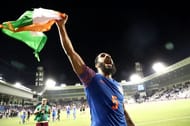Football in India is going through its worst possible turmoil right now. Or better to put it this way- The world has started to take notice of the perpetual chaos in football of this third-world country for the first time due to its growing market, stature, and fan following.
While the merger of I League and ISL is still to be settled successfully, several new issues in the football system of India emerged. Recently, former Manchester United legend and ex-ATK manager, Teddy Sheringham highlighted poor diets of footballers in India. Additionally, Croatia’s manager, Zlatko Dalic stated that Indian leagues have too many foreign players. The current Indian national team manager, Igor Stimac advocated for an extended football season in India (till May like other countries), requesting football administrators in India to prioritise benefit of football ahead of a potential loss of television coverage to the country’s biggest cricket extravaganza, the Indian Premier League (IPL).
However, the scepticism over the eligibility of the Persons of Indian Origin (PIO) and Overseas Citizens of India (OCI) to play for the Indian national football team is the most concerning topic of discussion among major footballing fraternities in the country right now.
India’s worsening FIFA ranking, fans’ growing expectations, and increasing pressure to perform, especially from neighbouring countries like China urged the current boss, Igor Stimac to put forward the proposal of fielding PIOs and OCIs in Indian colours.
Nevertheless, the matter is not contemporary. The genesis of the discussions on PIO and OCI’s eligibility to play for the Blue Tigers lies way back in time. It was first brought into consideration notably by Bob Houghton when he was the manager of the Indian national football team in the year 2006.
Houghton tried to add the most prolific Indian origin football player at that time, Michael Chopra to his squad. Chopra, the ex-Newcastle United striker, was then plying his trade with Cardiff City Football Club.
However, due to the Indian Government’s stern citizenship rules, the prospect of Chopra wearing the Indian jersey never materialized. Later head coach, Stephan Constantine, also made several failed attempts to push for the inclusion of PIO and OCI players in the national team selection pool.
What are the regulations of the Indian Government and FIFA in this matter?

The Indian Government has a clear stand on its citizenship regulations. Dual nationality is strictly prohibited and to obtain an Indian passport a person has to stay in India for a year at least. Till date, Izumi Arata is perhaps the only successful PIO to play for India.
Having been born to a Japanese mother and an Indian father in Japan, Arata initially held a Japanese passport. Acceding to the rigid citizenship rules of Indian Government, the Indian-Japanese footballer gave up his Japanese passport to earn the right to represent India in 2013.
The regulations of FIFA regarding player’s eligibility to play for a country are comparatively less stringent to those of the Indian government. The leniency in rules allows countries to constitute the best possible teams ensuring competitiveness and exciting football spectacle across the globe.
In the most recent FIFA World Cup 2018, out of a total of 736 players, 82 were not born in the country they represented. Additionally, 22 teams out of total 32 had at least one or more foreign-born player. According to the football’s international governing body, players can represent any country of which they are a citizen of.
For example, Lionel Messi holds dual nationality of Argentina (due to birth) and Spain (naturalized due to prolonged stay and profession). Under FIFA’s citizenship guideline, Messi was eligible to represent either country. Everyone knows the choice Messi made.

However, to forbid players from selling their citizenship to the highest bidder among different national federations competing for the best talents, FIFA permits players to switch between their nationalities only till they have represented a country in a competitive match at senior level. Once done so, a player is tied with a nation for life.
For instance, Diego Costa was eligible to play for both Brazil and Spain. He opted to represent Spain in the World Cup 2014 despite having played for Brazil in two friendlies in the past. Costa’s switch was legitimate as FIFA doesn’t regard friendlies and exhibition matches as competitive matches.
Why is this issue about the Indian national football team in the news?

The current Indian national team manager, Igor Stimac strongly advocated for making eminent PIO and OCI players playing in respected leagues around the world to be made available for the national team selection.
His desire comes as an aftermath of India’s disappointing FIFA World Cup 2022 qualification campaign where the Indian national football team's chances of going through to the next stage are looking bleak. Also, India is ranked embarrassingly as low as 108 in the latest FIFA rankings.
According to ESPN, it is evident that the Croatian is seriously interested in Iran's Indian-origin player Omid Singh to join his team. East Bengal’s latest signing Omid Singh’s father holds an Indian passport making him eligible to represent India according to FIFA rules immediately. The office-bearers of the All India Football Federation (AIFF) are also moving earth and heaven to convince the government of India, especially the Sports Minister of India, Kiran Rijiju to relax the longstanding existing rules related to citizenships of sportspersons.

The AIFF is hoping to take advantage of the Modi government’s affinity towards Pravasi Bhartiya (Non-resident Indians, NRIs) to break the deadlock. Swansea’s Yan Dhanda, Stoke City’s Danny Batth, Leicester City’s Sim Thandi, Mansfield Town’s Malvind Benning, and Bournemouth’s Dinesh Gillela are other promising footballers who can be considered for the Indian national football team if the regulations are altered.
The way forward – A critical perspective

One of the most successful Indian players in recent history, Sandesh Jhinghan quoted, "I love my country so much. I have always had this pride. When I left the national team camp as a teenager in 2010, I promised myself I would never sing the national anthem until I made the national team."
The alteration in India’s citizenship policy can prove to be a double-edged sword. It is obvious that by making PIO and OCI players eligible for selection will help the Indian national football team to improve their FIFA rankings and enhance their chances of qualifying the FIFA World Cup.
However, the impact of this changed rule in the development of grassroots football can be detrimental. Given the fact that the foreign-born Indian players will have better access to training facilities and football structure abroad, they are expected to have a greater competitive advantage over the homegrown Indian players.
The gap between the players representing the Indian team while living abroad and the players craving to wear the Indian national football team colours while training hard on dusty, scorching home turfs will only become greater with time. Ultimately, it will lead to fewer opportunities and playing for the country may becomie a distant dream for many India-based players at the grassroots level.
The national federation will brag about the Indian national football team's rise in the FIFA rankings and national team coaches will be able to better their resume for more lucrative offers. The initiatives to improve grassroots football in India will be at risk of suffering a setback. The success at the highest level can also lead to slackness and lack of funding for grassroots projects.
Unless the abovementioned concerns are addressed and AIFF commits to improve the infrastructure and club football, the idea of allowing PIO and OCI to represent the Indian national football team can prove to be catastrophic. Sooner like rugby in Japan, football in India can become a sport of the immigrants and wealthy natives. Indians can witness the tricolour at the FIFA World Cup in the near future. However, it will be interesting to see how many of the players standing under the Indian flag are able to sing the national anthem.
